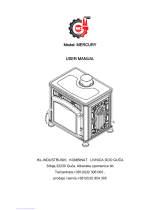
3
ENGLISH RAIS - Manual for Rais Topas & Opus
Rais Topas
Rais Opus
Revision: 2
Dato : December 2009
INTRODUCTION .................................................................................................................................. 4
WARRANTY ......................................................................................................................................... 4
SPECIFICATIONS .................................................................................................................................. 5
CONVECTION ...................................................................................................................................... 6
INSTALLATION INSTRUCTIONS .............................................................................................................. 7
CHIMNEY ........................................................................................................................................ 8-9
INSTALLATION .................................................................................................................................... 10
OPERATION OF SWIVEL BASE ............................................................................................................ 12
CHANGE OF CHIMNEY CONNECTION ........................................................................................... 13-15
INSTALLATION DISTANCE IN CASE OF COMBUSTIBLE WALL ............................................................... 16
GENERAL INSTALLATION (RIGHT ANGLE) SECURE BASE .................................................................... 17
CORNER INSTALLATION 45° ............................................................................................................. 17
360° SWIVEL BASE ............................................................................................................................ 18
INSTALLATION DISTANCE IN CASE OF NON-COMBUSTIBLE WALL ...................................................... 18
FOR THE INSTALLER ........................................................................................................................... 19
OPERATING INSTRUCTIONS ................................................................................................................ 20
FUEL ........................................................................................................................................... 20-21
DRYING AND STORAGE .................................................................................................................... 21
REGULATION OF COMBUSTION AIR .................................................................................................. 22
ROOM VENTILATION AND STOVES .................................................................................................... 22
USING THE WOOD BURNING STOVE ................................................................................................ 24
ADJUSTMENT OF AIR DAMPER ......................................................................................................... 24
CONTROL ......................................................................................................................................... 24
FIRST USAGE .................................................................................................................................... 25
LIGHTNING AND FUELLING ........................................................................................................... 26-27
CLEANING AND CARE ..................................................................................................................... 28
CLEANING OF THE FLUE WAYS .......................................................................................................... 29
INTERRUPTION OF OPERATION ......................................................................................................... 30
ACCESSORIES AND SPARE PARTS ....................................................................................................... 31
SPARE PART DIAGRAMS RAIS TOPAS ............................................................................................ 32-33
SPARE PART DIAGRAMS RAIS OPUS ............................................................................................. 34-35




















